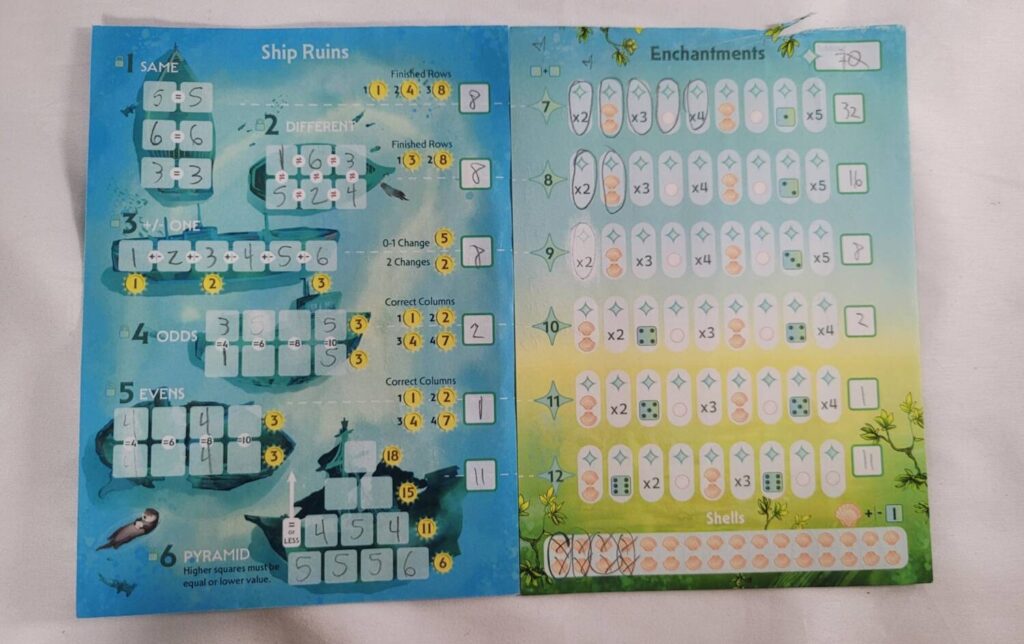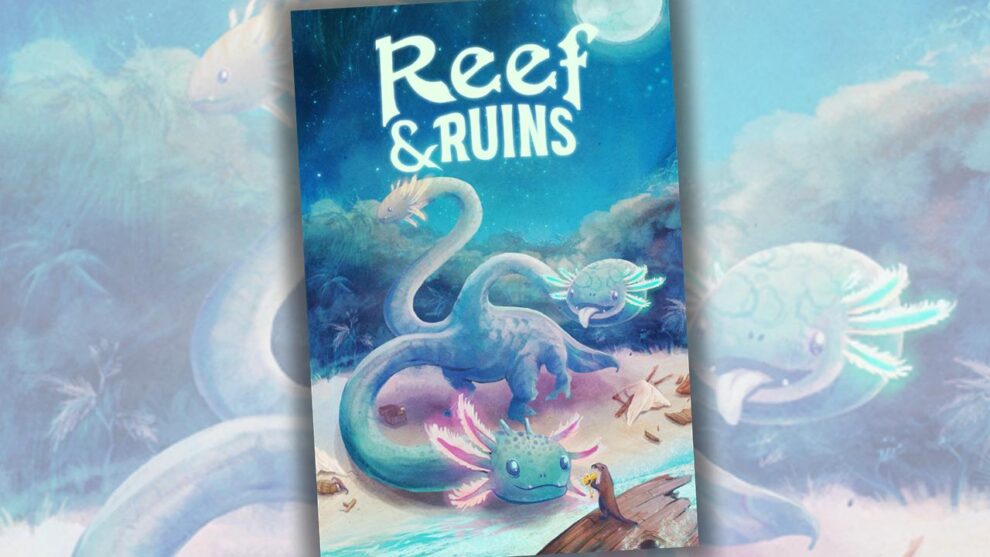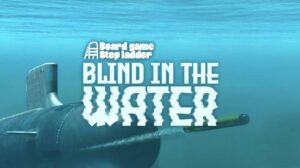Disclosure: Meeple Mountain received a free copy of this product in exchange for an honest, unbiased review. This review is not intended to be an endorsement.
In classic mythology, the hydra was a many-headed demon that proved very hard to kill. As if its poisonous breath and tainted blood weren’t enough, a hero attempting to slay a hydra would have to contend with its heads not just regenerating, but doubling, just as quickly as they were lopped off. Back then, the hydra was a friendless, angry beast.
The modern hydra is a much friendlier, more jovial hydra. Much of that is due, no doubt, to the hydra’s affection for the loveable, peaceable otter. Nothing pleases a hydra more than making its otter friends happy and, if there’s one thing that makes them happier than anything, it’s shiny stuff.
In Reef & Ruins, from Carla Kopp (Way Too Many Cats, Roar and Write!), players take on the roles of otters directing their 3-headed friends (represented by three 6-sided dice) as they search through the ruins of wrecked ships and the surrounding reefs for treasure. If they’re feeling particularly generous, they’ll even impart some of their magical essence into their finds to make them even shinier, enhancing their overall value for the end game.
Each round, a player will roll the three dice and players will use those dice however they wish across their three sheets: Ship Ruins, Enchantments, and Reef. Everything a player does will earn them points. After 18 turns, the players tally their final scores, and the player with the most points will win the game.
Of course, this is a high-level overview of the game. Read on if you’d like to learn a little more about how the game is played. Otherwise, skip ahead to the Thoughts section to find out what I think.
Enchantment Under the Sea
Before beginning a game of Reef & Ruins, each player should be given a pencil, a Ship Ruins sheet, an Enchantments sheet, and a Reef sheet. In the pre-production copy that I received, the Reef sheet is double-sided with a different type of Reef on each side. Players should agree on which side they’ll be using. The round tracker card is placed close by with the otter figurine placed onto the 1 position. The players each select a number between 1 and 6 to act as their Lucky Number and note this number in the provided space on the Reef sheet. Then, a start player is selected by some means and given the three dice. Now, you’re ready to play.

At the start of a round, one of the players will roll the three dice. Then, each player takes their turn simultaneously. What a player decides to do with the dice is entirely up to them, but they must follow the rules for whichever feature(s) they decide to devote their dice to. In general, a player will be using one or more of their dice to select a ruin type and write a value (or multiple values) into it, using at least two dice to cross off a space on the Enchantment sheet, sacrificing a die to gain 2 shells (which can be spent to manipulate the values of the dice) or some combination thereof.
The Ship Ruins sheet is made up of six distinct types of ruins. Each of these types accepts dice, and scores, in a different way. Ruin 1 wants matching sets of dice. The more matched sets that have been attributed to this by the end of the game, the more it will score. Ruin 2 accepts any dice, so long as the newly accepted ones are different from all those that have come before. The better you are able to accomplish this, the better your end score will be. You get the idea.
The Enchantments sheet is an extension of the Ship Ruins sheet. On this sheet are six Enchantment rows, each directly connected to one of the ruin types on the Ship Ruins sheet. The number 7 is connected to the number 1, 8 is connected to 2, 9 is connected to 3, etc. all the way up through the number 12, which is connected to 6. Each Enchantment row is composed of nine columns. When a player fills in an Enchantment, they begin with the leftmost column of the appropriate row, crossing off the Enchantment and receiving its bonus. The types of bonuses vary between an end-of-game multiplier, a couple of shells, pearl bonuses from the Reef sheet (which we’ll talk about shortly), or a free die face of a specific value which can be used anywhere.

The Reef sheet in my copy features one of two possible reefs. In one reef, you’ll spend your dice to fill in the reef using polyomino shapes. Each shape is specific to a particular die value. Filling in entire rows or columns will result in opportunities to mark off pearl bonuses (free die faces, straight up end-of-games-points, the ability to mark off the next symbol in an Enchantment column, etc.). The other side of the sheet features squares with printed numbers. Beginning with the center square (which is considered to already be marked off), players may only mark off a square if it’s orthogonally adjacent to a previously marked off square. To mark off a square, you’ve got to use a die value equal to the number printed on the square. Just like the opposite side, there will be numerous opportunities to earn valuable pearl bonuses.
After each round of play, the otter will advance one space on the round tracker. This may trigger a free bonus which all of the players will handle before the dice are rolled. After 18 such rounds, the game ends and final points are tallied.
Firstly, each ruin type is scored and the final score is written in the empty box next to the ruin on the Ship Ruins sheet. Then, these values are carried over to the Enchantments sheet and written into the boxes of the Enchantment types to which they are connected, adjusted by the highest unlocked multiplier. For instance, if Ruin 1 scored 8 points and you’d managed to unlock the x3 multiplier for Enchantment 7, you’d write 24 in the box on the Enchantments sheet at the end of Row 7. But, if you hadn’t unlocked any multipliers for Row 7, you’d write 8 in the box instead. The values of these boxes on the Enchantments sheet are added together to determine the Enchantment subtotal which, for some strange reason, is notated at the top of the sheet instead of the bottom where you’d expect the subtotal to be. This value is carried over to the Enchantment total box on the Reef sheet which begs the question of why the subtotal box exists on the Enchantments sheet at all.

But, I digress. After determining your Enchantment total, you’ll earn two points for each time you have used the Lucky Number you selected at the beginning of the game. This amount is noted in the Lucky Number Bonus box. Finally, add up any points you may have earned from pearl bonuses and note this in the Reef Bonuses box. These three numbers are added together to determine your final score. The player with the most points wins. And, if two players tie for high score, the winner is the next player in line who has not tied with someone else.
Thoughts
For the most part, I’ve enjoyed my experience with Reef & Ruins thus far, but I did encounter a few instances with this prototype where I had to reach out to the designer for clarification. I chalk this up to the rule book which I received that was almost entirely devoid of any kinds of examples or illustrations. For instance, the rule book tells me that the blue star symbol signifies that I can “gain any Enchantment”. This icon literally appears in every single icon grouping on the Enchantments sheet which caused me no end of consternation as I was trying to learn the game. Furthermore, the phrase “gain any Enchantment” could be interpreted as “gain any Enchantment regardless of whether you’ve filled in the other Enchantments in the same row already”. Played as it is written, what’s to stop me from simply crossing out the x5 multiplier on any given row without doing the work to actually reach that milestone? Needless to say, the rule book as it stands definitely needs some extra attention.
Aside from my gripes about the rule book and the placement of the Enchantment total box, which I mentioned earlier, my only other negative is one which will, no doubt, turn away some players. Namely, Reef & Ruins is entirely without player interaction. This game is a heads down puzzler. No decision that you make will have the slightest bearing on anything your opponents are doing. While this isn’t a negative that bothers me personally, I’d be remiss if I didn’t at least mention it.
Reading all that, you may get the impression that I’m not a fan of the game. It’s quite the opposite, in fact. Reef & Ruins is a lightning fast roll and write game that gives you plenty of options to choose from without the need for performing a lot of mental gymnastics. With its quick playtime, it’s the perfect lunchtime game. With its easy ruleset and comfortable decision space, it’s a great introduction into the roll and write genre of modern board gaming.











Beautifully written!